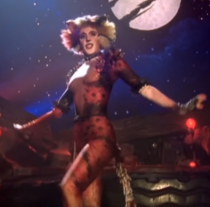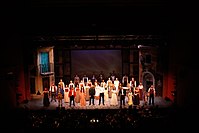
Musical theatre is a form of theatrical performance that combines songs, spoken dialogue, acting and dance. The story and emotional content of a musical – humor, pathos, love, anger – are communicated through words, music, movement and technical aspects of the entertainment as an integrated whole. Although musical theatre overlaps with other theatrical forms like opera and dance, it may be distinguished by the equal importance given to the music as compared with the dialogue, movement and other elements. Since the early 20th century, musical theatre stage works have generally been called, simply, musicals.

Cats is a sung-through musical with music by Andrew Lloyd Webber. It is based on the 1939 poetry collection Old Possum's Book of Practical Cats by T. S. Eliot. The musical tells the story of a tribe of cats called the Jellicles and the night they make the "Jellicle choice" by deciding which cat will ascend to the Heaviside Layer and come back to a new life. As of 2022, Cats remains the fifth-longest-running Broadway show and the seventh-longest-running West End show.

Sir Cameron Anthony Mackintosh is a British theatrical producer and theatre owner notable for his association with many commercially successful musicals. At the height of his success in 1990, he was described as being "the most successful, influential and powerful theatrical producer in the world" by the New York Times. He is the producer of shows including Les Misérables, The Phantom of the Opera, Cats, Miss Saigon, Mary Poppins, Oliver!, and Hamilton.

The Phantom of the Opera is a musical with music by Andrew Lloyd Webber, lyrics by Charles Hart, additional lyrics by Richard Stilgoe and a libretto by Lloyd Webber and Stilgoe. Based on the 1910 French novel of the same name by Gaston Leroux, it tells the tragic story of a beautiful soprano, Christine Daaé, who becomes the obsession of a mysterious, masked musical genius living in the subterranean labyrinth beneath the Paris Opéra House.

The Gielgud Theatre is a West End theatre, located on Shaftesbury Avenue, at the corner of Rupert Street, in the City of Westminster, London. The house currently has 994 seats on three levels.
Rum Tum Tugger is one of the many feline characters in the 1939 poetry book Old Possum's Book of Practical Cats by T. S. Eliot, and in the 1981 musical Cats which is based on Eliot's book. Rum Tum Tugger is a rebellious Jellicle cat who loves to be the center of attention.

The Really Useful Group Ltd. (RUG) is an international company set up in 1977 by Andrew Lloyd Webber. It is involved in theatre, film, television, video and concert productions, merchandising, magazine publishing, records and music publishing. The name is inspired by a phrase from the children's book series The Railway Series in which Thomas the Tank Engine and the other locomotives are referred to as "Really Useful Engines".

Grizabella the Glamour Cat is a main character in the Andrew Lloyd Webber musical Cats. Lonely and decrepit, Grizabella seeks acceptance from the other Jellicle cats but is initially ostracised. She sings the most famous song from the musical, "Memory".

Old Deuteronomy is a character in T. S. Eliot's 1939 Old Possum's Book of Practical Cats and its 1981 musical adaptation, Cats. He is a wise and beloved elderly cat, further serving as the Jellicle patriarch in the musical. The role of Old Deuteronomy originated by Brian Blessed in the West End in 1981, and by Ken Page on Broadway in 1982. Judi Dench plays Old Deuteronomy in the 2019 film adaptation.
"Memory" is a show tune composed by Andrew Lloyd Webber, with lyrics by Trevor Nunn based on poems by T. S. Eliot. It was written for the 1981 musical Cats, where it is sung primarily by the character Grizabella as a melancholic remembrance of her glamorous past and as a plea for acceptance. "Memory" is the climax of the musical and by far its best-known song, having achieved mainstream success outside of the musical. According to musicologist Jessica Sternfeld, writing in 2006, it is "by some estimations the most successful song ever from a musical."
Mr. Mistoffelees is a character in T. S. Eliot's 1939 poetry book Old Possum's Book of Practical Cats and its 1981 musical adaptation, Andrew Lloyd Webber's Cats. Mistoffelees is a young black-and-white tuxedo cat with magical powers that he cannot yet fully control. He is a featured dancer and his signature move is the "Conjuring Turn", consisting of 24 consecutive fouettés en tournant. His chorus identity is sometimes named Quaxo.

Mungojerrie and Rumpleteazer are fictional characters in T. S. Eliot's 1939 poetry book Old Possum's Book of Practical Cats. The Jellicle cat duo are mischievous petty thieves who often cause trouble for their human family. Although originally published as part of a collection, the poem "Mungojerrie and Rumpleteazer" was published as a standalone book by Faber and Faber in 2018.

Munkustrap is a Jellicle cat from T. S. Eliot's 1939 poem "The Naming of Cats". He is a principal character and the main narrator in Andrew Lloyd Webber's 1981 musical Cats, which is based on Eliot's poems.

Skimbleshanks is a character in T. S. Eliot's 1939 book of poetry Old Possum's Book of Practical Cats and in Andrew Lloyd Webber's 1981 musical Cats, which is based on Eliot's book. The character is portrayed as a bright and energetic orange tabby cat who lives and works on the mail trains.

Jemima is a principal character in the musical Cats, written by Andrew Lloyd Webber based on the poetry of T. S. Eliot. The youngest member of the Jellicle cats, she is idealistic and very accepting of others. She becomes the first cat to accept the outcast Grizabella back into the tribe.
A concept musical is a work of musical theatre with a book and score structured to develop and embody a theme or message, rather than convey a narrative plot.
"(Of) The Awefull Battle of the Pekes and the Pollicles" is a poem by T. S. Eliot included in Old Possum's Book of Practical Cats, his 1939 book of light verse. It is also included in Andrew Lloyd Webber's 1981 musical Cats, which is an adaptation of the book.

Bombalurina is a principal character in the Andrew Lloyd Webber musical Cats. The musical is an adaptation of T. S. Eliot's 1939 poetry book Old Possum's Book of Practical Cats, and the character's name is given in the poem "The Naming of Cats". Bombalurina is a flirtatious, confident female and mischievous cat with a distinct red coat. The role was originated by Geraldine Gardner in the West End in 1981, and by Donna King on Broadway in 1982. In the 2019 film adaptation she is played by Taylor Swift.
Jellicle cats are a fictional type of feline from Old Possum's Book of Practical Cats, a 1939 collection of light poetry by T. S. Eliot. Jellicle cats were adapted for the 1981 stage musical Cats by Andrew Lloyd Webber, where the wide array of diverse Jellicles is central to the musical's worldbuilding.
















